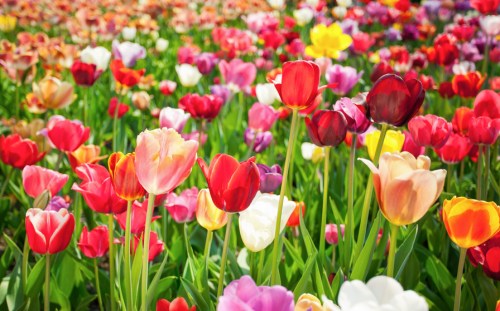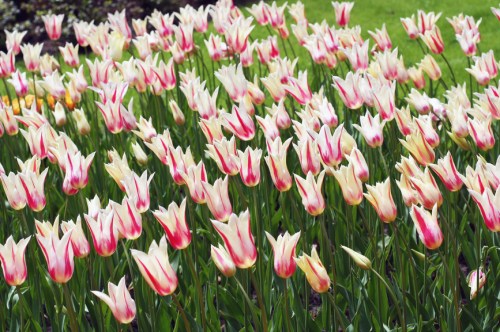Our editors independently select these products. Making a purchase through our links may earn Well+Good a commission
How To Plant Tulips in Your Garden for an Effortless Burst of Color That Returns Year After Year
Once you know how to plant tulips, you'll be rewarded each spring with the most colorful display in your garden year after year.

Once you know how to plant tulips, you’ll be rewarded each spring with the most colorful display in your garden. “Tulips have single flowers with three large petals and two or three large leaves. They come in a rainbow of different colors, shades, shapes, and stripes—from deep, glossy red to frilly, white and yellow, or even almost black,” says Clive Harris, gardening expert and creator of DIY Garden, a gardening and sustainability-focused blog. Over 4,000 different types of tulips have been bred over the years, but the one that’s still missing is a true blue,” he says. But still, when it comes to planting tulips in your garden, you’re spoiled for choice.
Experts in This Article
gardner, blogger, and founder of DIY Garden
The great thing about tulips is their relative ease to grow when planted in favorable conditions. “Tulips will grow in almost any soil that’s well-drained, but what they love best is a rich loam, or topsoil,” says Harris.
Bulbs grow with strong stems when planted at least 10 cms deep, and they can live for many years. “However, they tend to fade away after three or so seasons, which is shorter-lived in comparison with other bulbs, such as daffodils or crocus,” says Harris.

How To Plant Tulips
“Expert tulip growers lift bulbs when the flowers have finished and store them in a dark, dry place until autumn before planting out again,” says Harris. This can stop them from rotting, drying out or coming under attack from pests, but it isn’t necessary for good display and if you don’t want to dig them up each summer,” says Harris.
In general, it’s best to plant tulips in mid-autumn in order for them to bloom into flowers the following spring. “If you plant them in spring, they don’t have time to grow and flower that year,” explains Harris.
November is the best month to plant tulips, as the bulbs don’t mind the lower temperatures. (However, temperatures below freezing or harsh climates will destroy bulbs, and there may be presence of a fungus called tulip fire, which will rot on them.)
When planting tulips and their bulbs outside, choose a spot that gets plenty of sunshine and make sure you have at least 10 cms of depth. “The pointed ends should reach for the sky, with the loose roots touching loose soil,” he says. Water them well and be on the lookout for any pests in mid-spring that could draw near, such as slugs and snails, which tend to eat new foliage.
“Another tip is to cover the soil with horticultural grit, which prevents squirrels from digging up the bulbs,” he says. It’s also helpful for maintaining proper drainage and to avoid waterlogging. “Don’t worry, your tulips will just power through the grit,” Harris says.
You can also grow tulips indoors, if you don’t have the outdoors space. “Tulips will grow in a deep container too, just be sure to water them frequently and make sure the container is on feet, so excess water can drain freely,” he says. Again, waterlogging will rot beautiful tulip bulbs.
How To Care for Tulips Once They’re Cut
Cut tulips are a lovely alternative to roses, and they’ll last much longer if you know how to care for tulips at home. With the right steps, they’ll remain beautiful, healthy and strong.
- 1.Choose tulips closed up in buds at the store, as they’ll last longer when planted at home.
- 2.Snip off the stems by 1 cm to remove scabbing, which will enable greater water uptake.
- 3.Choose a cool spot for your vase, since cut tulips will wilt in the sun and in radiator heat.
- 4.Top off the vase with cold, fresh water every morning to hydrate parched tulips daily.
- 5.Empty and refill the entire vase every other day to keep it clean and fresh.
- 6.If any tulip looks rotten or diseased, remove it to avoid infecting the others.

How To Plant Tulips in Larger Quantities
When planting tulips, you may want to increase in numbers and create a collection of beautiful tulips, which often look better than simply planting one or two types. And if so, it’s smart to incorporate a variety of tulips’ sizes and styles to best complement one another.
You may want to buy tulips that vary in their heights and flower shapes, as the diversity will improve aesthetic and overall display, especially if your tulips are part of a collection of tulips.
“A mass of tulips always looks better than two or three,” says Harris. “For example, short stem tulips with frilled edges look beautiful when backfilled by tall slimline tulips with sleek flower-heads,” he continues.
If you love colors, go for a wide variety of shades when planting tulips at home. Or keep it simple with a swathe of pure white or blood red tulips, as another route. It’s all about personal preference, and the great thing about tulips is that they’re versatile.
How To Care for Tulips So They Last Longer
Once you’ve selected a spot for your tulips to grow, give them shelter from prevailing winds and rain, if they’re part of an outdoor garden and thus prone to exposure. “Strong winds batter tulips and destroy their petals, so planting tulips near a fence or area where they’re sheltered by an evergreen shrub are good choices,” says Harris. “A really good place to plant tulips is behind some summer flowering perennials because perennials cover-up tulips as their foliage dies back in summer,” he adds.
To keep tulips looking fresh in the border or in a container, cut off any seed heads, as they appear, as part of routine maintenance. “This lets the tulip’s strength head back into the bulb for a bigger display the following year, rather than creating seeds,” says Harris. You’ll simply snip off the seed head about an inch or so down the stem, as needed.
For the most beautiful tulip displays, replace your bulbs at least every three years. “Old bulbs can be planted in less-visited garden areas, where they will still flower, but not as well as young bulbs will, and in general, new bulbs always create the strongest, freshest flowers,” explains Harris.

How To Select Tulips for Planting
When buying tulips, first consider the range in flowering times and seasons, so you go into the process with a plan. “You can buy tulips that bloom in March, tulips that bloom in April to May, and late tulips that bloom in late May to June,” says Harris.
“All tulips have usually finished by mid-June, but spring isn’t the same without them, and you can extend the flowering season for more months of tulip loveliness by planting a selection of March to June varieties,” he explains.
Select healthy tulip bulbs from a garden center or order them online from a specialist tulip grower. When purchasing, make sure the tulip bulbs you’ve selected are ready to plant in November, which is the most favorable month for planting. “November planted tulips will flower March to May, depending on the type you’ve bought,” says Harris.
If you miss planting season, you can buy potted tulips, which are already in flower, both online and from a garden center. You’ll want to put them straight into the border, so they can continue growing, and you can treat them just as you’d treat your November planted bulbs.
Potted, flowering tulips are easy to find in the spring, as most nurseries and garden centers carry them, for they’re so beautiful and bright and thus attractive to customers.
“The best tulip bulbs for a garden include Darwin Hybrids, Emperor, and Kaufmanniana, and while you can buy them in lots of places, you should always stick with a reputable name to ensure your tulips are not leftovers from previous years,” advises Harris.
Figuring out how to buy tulips online is much simpler once you have a set grower in mind that’s been deemed reputable and of high quality.
“Online tulip growers generally have the best selection because they specialize in tulips and are always bringing in new hybrids to keep their selection exciting,” says Harris. “They often offer ready-selected mixes for good color schemes and shapes, too,” he adds.
If you buy tulips from a garden center, you can test their quality in-person by gently squeezing the bulb. “If it gives, if it’s soggy, or if it has a dent, don’t buy it,” says Harris, as tulip bulbs should be firm and show no signs of rotting, such as black spots, cuts or bruises.
You don’t want to buy tulips that are already decaying, so be vigilant when choosing your bulbs and make sure you’re buying the most pristine, healthy-looking bulbs you can find.
Oh hi! You look like someone who loves free workouts, discounts for cutting-edge wellness brands, and exclusive Well+Good content. Sign up for Well+, our online community of wellness insiders, and unlock your rewards instantly.
Sign Up for Our Daily Newsletter
Get all the latest in wellness, trends, food, fitness, beauty, and more delivered right to your inbox.
Got it, you've been added to our email list.








